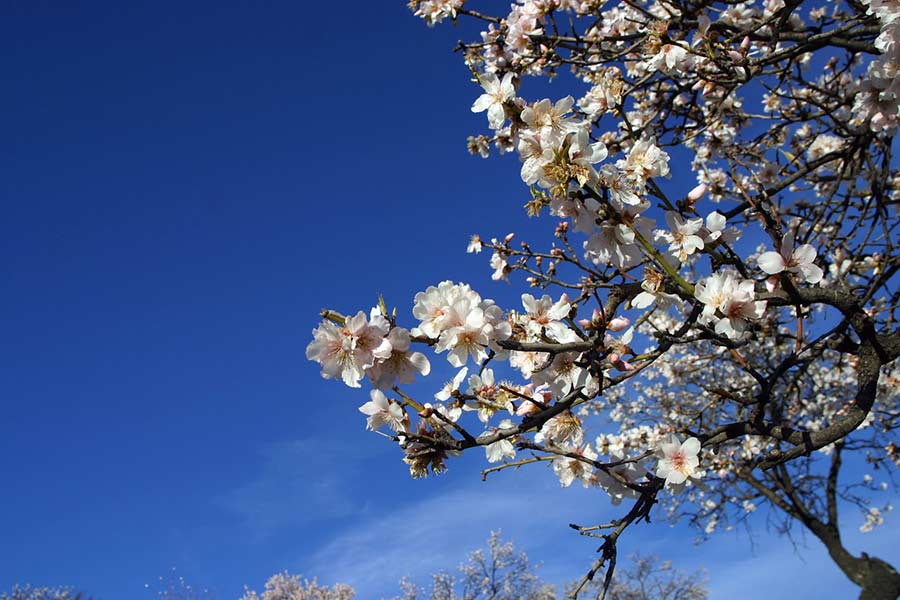The rust diseases encompass a large group of pathogenic fungi that infect an equally large and diverse group of plants. The common name ‘rust’ is quite descriptive of the physical appearance of the sporulating stage, which literally looks like yellow-orange rust deposits.
The rusts are very interesting to mycologists (specialists who study fungi) for various reasons. For one, rusts are considered to be one of the most highly developed groups of pathogenic fungi. Rusts are all ‘obligate’ parasites, dependent upon living hosts for growth. The prehistoric breadth of their development is represented by the complexity of their life cycles. In many cases, the rust organism will require two distinct sets of host plants to complete its life cycle. For example, stem rust of wheat (Puccinia graminis f. sp. tritici) has two stages of development that occur on barberry, while three stages occur on wheat. Each stage has a different morphology.

The Biology of Tranzschelia Discolor, the Fungi Behind Rust Disease of Stone Fruit and Nut
The causal organism of stone fruit and nut rust disease is called Tranzschelia discolor. Like its close relative, stem rust of wheat, T. discolor normally utilizes two separate hosts to complete its life cycle. The primary hosts are various stone fruit and nut trees, including almond, apricot, peach, nectarine, prune, plum, and cherry. The alternate host is the poppy anemone (Anemone coronaria).
Despite the need for the alternate host, like many ‘macrocyclic’ rust species (those requiring two separate hosts), T. discolor is capable of continued growth on stone fruit and nut trees. This occurs through repeated cycling of the uredial state, often referred to as the ‘repeating stage.’ That is, the uredial fruiting bodies can give rise to urediospores that repeatedly infect stone fruit and nut trees.
When the alternate host for stem rust of wheat—barberry—was first discovered, it was surmised that the destruction of the alternate host would interrupt the life cycle of the pathogen. However, the eradication of barberry merely disrupted opportunities for genetic recombination, with the fungus simply continuing through the repeating uredial stage.
This same principle holds true for T. discolor. One of the reasons that T. discolor has been observed more often in recent years is its requirement for extended moist periods for effective spore germi nation and infection. While pathogens such as brown rot (Monilinia fructicola) and grey mold (Botrytis cinerea), only require a 2 to 4-hour wetting period for germination and infection, T. discolor requires 12 to 18 hours.
During wet periods, spore populations increase dramatically, coinciding with the higher incidence of rust disease. The dangers associated with T. discolor are due, in part, to its ability to spread across vast distances. It is a wind-borne disease, and many times in past decades, it has been transported from a distant region to unsuspecting orchards that had never previously suffered from rust.
For instance, there was an epidemic of coffee rust in Brazil back in 1970. Following the outbreak, the cost of coffee rose dramatically, with 3-pound cans of coffee sometimes selling for more than $12 (nearly $80 today). While coffee rust was known to be indigenous to coffee-growing regions of Africa, it was unheard of on the South American continent. When an epidemiological study was completed, the rust spore inoculum was traced back to epidemics occurring in African coffee regions. Updrafts lifted huge spore loads, which eventually were caught in a jet stream which transported the rust spores more than 3,000 miles across the Atlantic Ocean, dropping them into Brazilian coffee plantations.
Similarly, stone fruit and nut tree rust are prevalent in Northern California, and not considered a threat in Central or Southern California. However, the prevailing winds in California are influenced by coastal winds coming off the Pacific Ocean. Entering through the Carquinez Straits at San Francisco, the winds split northwards into the Sacramento Valley and southwards into the San Joaquin Valley. Thus, spore loads produced in Northern California orchards can easily impact farmers in Central and Southern California.
T. discolor is a highly developed species. It has developed several strains, each of which has adapted to infect a specific species of stone fruit or nut trees:
- Almonds – T. discolor f. sp. dulcis
- Peaches, Nectarines – T. discolor f. sp. Persicae
- Prune – T. discolor f. sp. domesticae
Thus, a prune orchard adjacent to a rust-infected almond orchard would most likely be free of rust disease. The converse would also be true, in that an almond orchard downwind from a rustinfected prune tree would not incur infection from spores produces by fungi on the prune tree.
However, while specificity of T. discolor strains to host species does occur, this is not a hard and fast rule. For one, specificity is dynamic and subject to change. Although the repeating uredial stage is considered an asexual stage with absence of genetic recombination, a process known as ‘hyphal fusion’ provides an alternative means of exchange of genetic materials between adjacent colonies. Thus, the likelihood of producing a fruiting body and spores from a new uredium may be enhanced. This entire process of asexual genetic exchange is referred to in mycology as ‘heterokaryosis.’
The rationale for this complex alternative means of reproduction is made obvious with an example. Consider an area which multiple orchards with various species of almonds, prunes, and peaches. A strain of T. discolor that is limited to only a single species of host has a seriously diminished ability to spread, due to the variation in nearby posts. This is an environment that places selective pressures on strains of T. discolor to adapt in order to infect all nearby species. Indeed, in areas with diverse plantings, it has been observed that T. discolor from peaches can in fact be transferred to almonds. Furthermore, international pathologists report that only partial specificity exists in T. discolor rust species found on Australian plantings.
The Impact of Rust Disease on Stone Fruit and Nut Trees
The primary effects of rust disease of stone fruit and nut trees occurs in the reductions in carbon harvest resulting from defoliation of infected leaves. In most cases, growers spray fungicides in the spring, targeting such diseases as brown rot or shothole, which also control rust. However, in the latter part of the season (i.e. early- to mid-fall), or following harvest, growers tend to back off from sprays.
Secondly, the literature is replete with statements to the effect that “control of rust is not warranted,” which encourages a relaxed attitude towards the disease. The danger of this is that premature defoliation robs trees of the additional carbon harvest necessary to strengthen canopy tissues, roots, and buds. Premature defoliation from rust infections is akin to incurring severe mite infestations.
Oftentimes, the effects go beyond reducing carbon harvest, in many cases followed by sudden awakening of latent buds and an untimely resurgence of vegetative growth. This further depletes the trees of carbon reserves which are normally stored to support the next season’s bud push. Premature defoliation is frequently correlated with alternate bearing. Thus, it is a problem that is nothing short of costly.
Control of Rust Disease
Rust is easily controlled by sulfur fungicide applications (which should be avoided with apricots). Studies by Michailides and Ogawa indicate that the ethylene bis-dithiocarbamates (EBDCs), such as Mancozeb, display superior control over that of sulfur. We have also observed excellent control with Ziram, Captan and Bravo (chlorothalonil).
An effective treatment program involves the early fall application of fungicide, nutrients, and organosilicone spreader. Organo-silicone spreading agents impart a decisive efficiency to the spray materials, increasing their effectiveness by a large magnitude.
Preventative measures against rust rely on maintaining high tissue integrity of the foliage and green stems. We have observed, for example, that trees on superior nutritional programs that emphasize optimal levels of calcium, potassium, phosphorus, and boron are enhanced in their resistance to rust disease.
The overall health of a tree or plant has an enormous impact on the severity of the effects of rust. This is demonstrated by considering rust disease of turf. With this disease, the most severe cases occur in shaded areas. The shaded area does not, as many assume, merely enhance the wetting period necessary for spore germination and infection. In addition, it detracts from efficient carbon harvest, which would otherwise contribute to high tissue integrity and natural resistance to infection.
Thus, excessive or imbalanced nitrogen fertilization, which promotes rank, tender tissues, also contributes to rust disease. As we begin to lose more and more of our chemical arsenal, we will need to supplement our programs with more refined nutritional programs.
Overview of Rust Disease of Stone Fruit and Nut Trees
- Rust is a disease that requires relatively longer periods of wetting for infection.
- Recurring rainy and wet seasons allow for the build-up of rust inoculum.
- The rust pathogen can be easily transported long distances by wind.
- There is evidence that Tranzschelia discolor has specialized strains specific to particular stone fruit species. This specificity of host species means that the likelihood of spores hopping from one host species to another is relatively low.
- The presence of hyphal fusion and genetic exchange does endow rust fungus with the ability to adapt to a variety of stone fruit hosts. Thus, one must view specificity of strains as a dynamic and often short-lived phenomenon, given selective pressures that promote broad-spectrum infectious strains.
- The rust fungus is best controlled in the late summer or early fall with sulfur or EDBC fungicides. It has also been observed that Ziram, Captan and Bravo are quite effective against rust.
- Experience has demonstrated that natural resistance to rust is enhanced with superior nutrition that increases the tissue integrity of the host leaves and stems.




